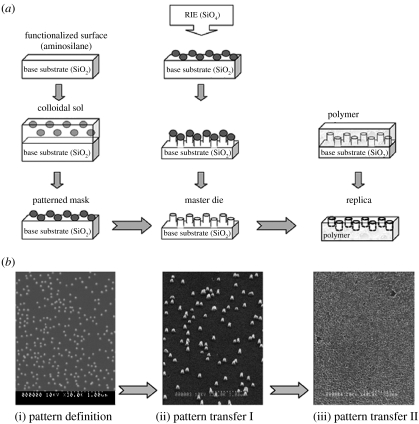Figure 2.
Overview of the main nanolithography steps used during fabrication, where colloids are utilized as a model system. A schematic overview is provided in (a), with scanning electron microscope (Hitachi S-900) images of the final patterns provided in (b). Pattern definition (i) requires a mask to be produced, in this instance by functionalizing a base substrate of silica and immersing in a colloidal sol, producing a patterned mask following sol evaporation (50 nm diameter colloidal gold particles in (b)). Pattern transfer I (ii) uses additive or subtractive techniques to produce a master die, for example, colloids can be used as a mask during reactive ion etching (RIE), where ions etch around the mask, producing, in this instance, a pillared topography (50 nm diameter, 200 nm high pillars, (b) with colloids removed post-etch). Colloids can subsequently be removed using a gold etch, resulting in a pillared master die with uniform chemistry. Pattern transfer II (iii), a process often termed replication technologies, uses a polymeric material to produce many copies of the master die topography, inversely (20 nm diameter, 200 nm deep nanopits in polystyrene, (b)).

